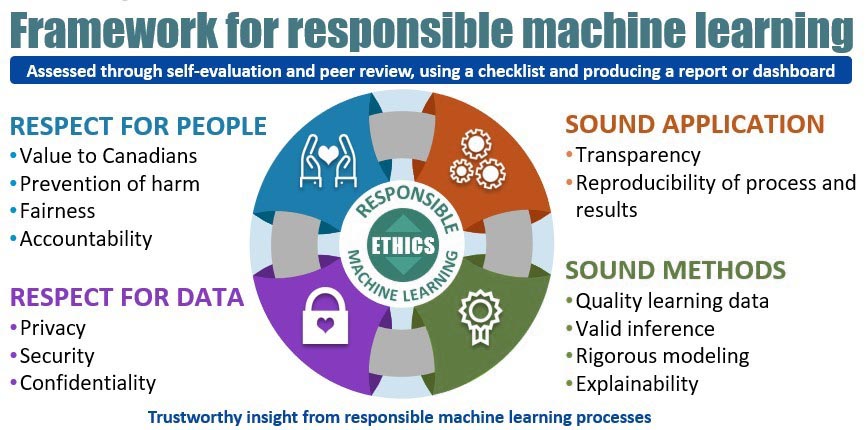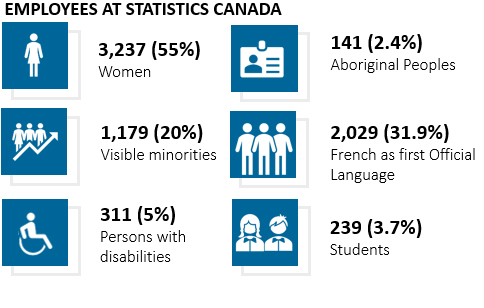Statistical information
Description
Statistics Canada produces objective, high-quality statistical information for the whole of Canada. The statistical information produced relates to the commercial, industrial, financial, social, economic, environmental and general activities and conditions of the people of Canada.
Results
At the onset of the COVID-19 pandemic, when Canadians needed timely and accurate data to support evidence-based decision making, Statistics Canada adapted quickly to respond to urgent data needs. In fact, the pandemic accelerated Statistics Canada's ongoing efforts to modernize its operations and promote a culture of innovation.
Overnight, Statistics Canada's employees pivoted to working virtually, while developing new methods to collect, analyze and share data safely, securely and remotely. The agency documented unprecedented changes to Canada's economy, including sudden shifts in industrial activity that dramatically impacted supply chains, particularly in the agriculture, energy and transportation sectors. These rapid shifts affected consumer behaviour, resulting in sudden changes in the prices of certain goods and services.
The agency's employees tracked price fluctuations for its monthly measure of inflation without stepping into a single store. They measured employment trends without interviewing anyone on their doorstep. They released monthly flash estimates of high-frequency economic indicators, such as gross domestic product. And, using new data collection methods, such as crowdsourcing, Statistics Canada published its first-ever study of how Canadians experienced discrimination during the pandemic.
In the early days of the pandemic, the agency partnered with the Canadian Chamber of Commerce, the country's largest business group, to examine the impact of the nationwide economic shutdown on the country's firms. The results of the quarterly Canadian Survey on Business Conditions were vital in providing the Government of Canada with the information it needed to design and implement emergency income-support programs that met the urgent needs of the moment. These programs have helped backstop the Canadian economy better than those in other G7 countries. As Canada moves from pandemic response to recovery, Canadian businesses continue to rely on the results of this quarterly survey to adjust their operations and outlook in response to economic uncertainties created by the pandemic.
The agency also produced crucial data on employment, health, safety, business closures, consumption trends, immigration levels, interest rates and housing prices, in addition to providing statistical evidence that the COVID-19 pandemic has had an unequal impact on diverse populations, which has sharpened existing social and income inequalities. In continuing to track levels of economic activity, Statistics Canada has identified a modest and uneven recovery that continues to sharpen social and economic inequality, especially among women, young people, Indigenous people, workers without a postsecondary education, new immigrants and groups designated as visible minorities.
Above all, 2020–21 has underscored the importance of partnerships in ensuring that Statistics Canada remains responsive to the rapidly evolving data needs of Canadians. For that reason, the agency has forged ongoing collaborations, not only with other federal departments and agencies, but also with other orders of government, civil society groups and organizations in the private sector.
In addition, the agency continues to develop new digital platforms that enable the country's researchers to access Statistics Canada's vast data holdings as quickly and securely as possible. In that way, the agency plays a key role within the nation's research ecosystem and in a knowledge-based economy. Statistics Canada's data and insights help accelerate the pace of discovery and innovation. Through its vast data holdings, rigorous data methods, and ability to produce rich and detailed microdata sets, the agency helps generate new ideas and move the goalposts of knowledge.
However, getting more value out of data for Canadians does not mean sacrificing the protection of personal information. As a trusted data steward, Statistics Canada is unwavering in upholding its legal duty to collect, store and use data responsibly and to protect the data in its care. Through the agency's online Trust Centre, Statistics Canada engages in an ongoing dialogue with Canadians about how it collects and uses data on behalf of the people of Canada, while protecting their privacy and safeguarding the confidentiality of the data they have entrusted to the agency.
Statistics Canada is working to strengthen the overall quality of the national statistical system. In 2020–21, the agency facilitated 10 meetings of the Canadian Statistics Advisory Council (CSAC). This council is mandated to provide advice to the Minister of Innovation, Science and Industry and the Chief Statistician of Canada on matters related to the overall quality of the national statistical system. These matters may include the relevance, accuracy, accessibility and timeliness of the agency's data. In October 2020, the CSAC released its first annual report, providing a detailed assessment of Canada's statistical system and guidance on how to strengthen it. Over the past year, Statistics Canada has worked closely with the CSAC and partners inside and outside the Government of Canada to deliver results in the areas outlined in the report. Statistics Canada is grateful for the advice and guidance of the members of the CSAC.
Modernization pillars
Providing user-centric services

- 2021 Census
- Engaging Canadians
- StatCanPlus
- Collaborative Platforms
- Accessing data virtually
- Providing more granular, disaggregated data
- Providing COVID-19 data in a time of uncertainty
Developing leading-edge methods

- Flash estimates
- Web scraping
- Crowdsourcing
- COVID-19 Communication Geospatial Tool
- Canadian Economic Dashboard
- Data Science
- Machine Learning Framework
- Social Data Integration Platform
Building statistical capacity and leadership

- Statistics Canada Data Strategy
- Data Literacy Training Initiative (DLTI)
- Data Science Network for the Federal Public Service
- Canada School of Public Service Digital Academy
- Personal Protective Equipment (PPE) Data Strategy
- Centre for Gender, Diversity and Inclusion Statistics
Engaging with Canadians

- Partnering with government departments (city, municipal, provincial & federal) through the pandemic
- Canadian Centre for Energy Information (CCEI)
- Northern Data Strategy
- International
- Private Sector
- 2030 Agenda for Sustainable Development
- Academia and Researchers
- Public engagement
Designing a modern and flexible workplace

- Equipping employees for remote work
- Cloud initiative
- Beyond 2020
- Protecting employee mental health and well-being
- Diversity and Inclusion
Providing user-centric services

As part of the agency's ongoing efforts to modernize its operations, Statistics Canada participated in the pandemic response by fast-tracking initiatives that were already underway to develop new solutions that provide Canadians with easier, more convenient ways to access its vast data holdings.
Adapting the 2021 Census for COVID-19
The agency's major undertaking in 2020–21 was to ensure that the 2021 Census of Population could be conducted during a pandemic safely, securely and remotely. The decision to revise the collection plan was made with the health and safety of both respondents and enumerators as the top priority. The 2021 Census was adapted to ensure that every Canadian had the opportunity to be heard in the safest way possible. That meant setting up virtual offices, training census employees remotely, and limiting in-person contact between enumerators and respondents. As part of a rapid scale-up of census operations, nearly 1,200 temporary staff were initially hired, culminating in a total of more than 30,000 staff recruited by the end of the fiscal year 2020–21.
Following consultations that took place in 2019–20, Statistics Canada continued to engage with Canadians in 2020–21 through seven virtual roundtable discussions. This dialogue with Canadians focused on proposed changes to the 2021 Census that, among other topics, included new questions related to gender, Indigenous peoples, official language education, military service and veterans, and employment status during the pandemic.
The 2021 Census of Agriculture, which collects data on Canada's agriculture sector, was also adapted to reduce the number of surveys that farm operators were asked to fill out and to eliminate in-person contact between them and enumerators. The Census of Agriculture is the only data source that provides a comprehensive and integrated profile of the physical, economic, social and environmental aspects of Canada's agriculture industry for small geographic areas. Users in the private sector see the Census of Agriculture as an important tool for business and investment planning. Farming groups use Census of Agriculture data as a foundation for their discussions with governments and trade organizations and to evaluate the impact of natural disasters, such as fires, floods, droughts and storms, on the sector.
Engaging with Canadians during COVID-19
Over the 2020–21 fiscal year, Canadians engaged with Statistics Canada's website and social media channels more than ever before. Engagement levels exceeded all of the agency's targets. Indeed, the volume of social media engagement more than doubled from its initial targets, proving that Canadians viewed Statistics Canada as vital to their everyday lives, regardless of where they were located.
| Performance Indicators | Fiscal year targets | End of fiscal year 2020–21 results |
|---|---|---|
| Media citations | 60,000 | 253,171 (422%) |
| Social media engagements | 641,300 | 1,043,628 (162%) |
| Social media impressions | 23,723,950 | 38,432,673 (163%) |
| Social media followers | 321,500 | 404,402 (123%) |
In addition, the agency conducted a market analysis to better understand the preferences of Canadians who use its website. The goal was to identify opportunities to expand the reach of the agency's web-based products and services. That analysis resulted in the development of new ways to reach diverse populations through storytelling, infographics, interactive data visualizations and topic-specific web portals. Over the 2020–21 fiscal year, Statistics Canada provided a total of 40,738 data products on its website—a 4.5% increase from its stated target. Another 7,755 data tables were released through the Open Government Portal—an increase of 4% from its stated target.
Releasing timely information more frequently

Description - My Census Story
Contest alert – Calling all secondary and postsecondary students! Are you up for a #Census Challenge? We've partnered with the Statistical Society of Canada to bring you a new contest: #MyCensusStory!
Do you use statistical or #census data at school or in your personal life? Do you have a creative way to tell Canadians why it's important to complete their census questionnaire in May? If so, share your story with us starting on March 22 for a chance to win a prize: www12.statcan.gc.ca/census-recensement/contest-concours/index-eng.cfm
#2021Census #CensusCAN #CensusGeeks #Census #Students #Canada #StatisticsCanada
In December 2020, the agency launched StatCanplus portal. This first iteration will be leveraged to collect user feedback and gather analytics to inform the look, feel and capabilities of future iterations. The StatCanplus is the first step in providing a platform through which the agency can release information at multiple times throughout the day. This portal packages data and analysis in a way that is more accessible to the general public and business users through which the power of data storytelling can be better leveraged. The ultimate goal of the StatCanplus is to bridge some of the identified gaps in user needs to ensure Statistics Canada continues to connect with Canadians.
Developing a virtual platform for data scientists and researchers
Over the past year, Statistics Canada has made significant progress in the development of Data Analytics as a Service (DAaaS), a cloud-based computing platform that has revolutionized the way data scientists and researchers use and share statistical information. DAaaS provides users with virtual access to data and analytical tools and software on a secure and easy-to-use platform. Users can work within this secure platform to prepare and transform datasets, analyze and present data, and share data-driven insights.
In its first full year of service, DAaaS has attracted more users than expected. DAaaS put into service two key analytical platforms, the Advanced Analytics Workspace and the Collaborative Analytics Environment. The number of business solutions targeted to be onboarded to these platforms was set to four. However, its success was unparalleled, and DAaaS onboarded 23 business solutions, greatly exceeding its original target. This year's target primary user group was data scientists, where an unprecedented 84% uptake from within that community was observed. Overall, the number of components scheduled for release was set to 3, but the end result was a release of 17 components. These components were leveraged by close to 500 users, 50% more than anticipated for the year, 10% of which were external to the agency. Overall, it was a banner year for the program in terms of service delivery and user community uptake.
In collaboration with Health Canada and the Public Health Agency of Canada, Statistics Canada developed the personal protective equipment dashboard, which would not have been possible without the DAaaS platform. This tool helped governments track the national supply of personal protective equipment and ensure that those critical resources were distributed to where they were most needed.
Accessing data virtually
In 2020–21, the agency developed a variety of initiatives that enabled researchers to access Statistics Canada's data virtually. One of those initiatives is the Virtual Data Lab (VDL), which was piloted during the pandemic. When it is fully implemented, the VDL will provide authorized users with remote access to detailed, anonymized social and business microdata through a secure, cloud-based computing interface. Other initiatives to improve virtual data access included the launch of an interim solution to facilitate COVID-19 research and a pilot project that used cloud-based computing to facilitate a project on opioid use, conducted with federal partners.
Better data for better outcomes
Statistics Canada is responding to the growing demand for more detailed data to support decision making by all orders of government, including at the municipal level. The onset of the pandemic underscored the need for Canada's cities to have more detailed data at the local level to drive better decision making and outcomes. In 2020–21, Statistics Canada partnered with the City of Vancouver to pilot an approach to provide data at the municipal level, rather than at the traditional level of census metropolitan areas. This project marked an important step towards addressing data gaps at the community level and sets the stage for further collaboration with the Federation of Canadian Municipalities (FCM).
Statistics Canada has invested in four projects in partnership with the FCM aimed at improving awareness, data literacy and use of data by local governments. This partnership will in turn improve the agency's understanding of local issues and priorities, and identify potential opportunities to better serve Canadians' growing need for detailed data at the lowest level of geography possible.
Data to help pandemic responders see opportunities sooner and act faster

Description - Impact of Covid-19 on small businesses in Canada
| Percent of businesses unable to take on more debt | Percent of businesses that had the cash or liquid assets required to operate | |
|---|---|---|
| All employment sizes | 43.9 | 76.9 |
| 1 to 4 employees | 47.2 | 75.4 |
| 5 to 19 employees | 43.4 | 77.0 |
| 20 to 99 employees | 34.3 | 83.2 |
| 100 or more employees | 16.8 | 80.8 |
| Note: Respondents were asked if the business or organization had the ability to take on more debt, and if they had the cash or liquid assets required to operate. Source: Canadian Survey on Business Conditions: Impact of COVID-19 on businesses in Canada (Table 33-10-0286-01 and 33-10-0287-01). |
||
The COVID-19 pandemic has underscored the importance of data in effective decision making. In the middle of a rapidly evolving crisis, those who can see opportunities and challenges sooner can act faster—and smarter. As part of COVID-19: A data perspective, Statistics Canada produced data-driven insights about the economic, social and health impacts of COVID-19 on the people of Canada in ways that have shaped both the scale and the trajectory of the pandemic response. Below are some of those key insights:
- Uneven impacts: The pandemic did not affect all Canadians equally. Those who were hit hardest by job losses, reduced work hours and lost wages included women, Indigenous people, groups designated as visible minorities, young people and Canadians living with disabilities.
- Economic impacts: Overall levels of business activity remain below pre-pandemic levels, and pressures related to profitability and operating costs remain, with some sectors hit harder than others.
- Indirect health impacts: Actions taken to manage the pandemic may have lasting effects on the mental and physical health of Canadians.
- Demography: Canada witnessed a significant decline in population growth, chiefly resulting from a drop in immigration during the pandemic. Canada's population was estimated at 38,048,738 on January 1, 2021, an increase of 149,461 (+0.4%) year over year. This growth rate is the lowest since 1916 (+0.3%). In 2020, Canada welcomed 184,624 immigrants, the lowest number since 1998, and almost half (-45.9%) the number welcomed in 2019.
Developing leading-edge methods of data collection and integration

In a digital and data-driven world, Statistics Canada continued to modernize its operations in 2020–21 by moving beyond its traditional survey-first approach and including more alternative data sources. In doing so, the agency continued to reduce the number of surveys that Canadians are asked to fill out; find more efficient ways to collect, use and share data responsibly; and improve the reliability of the data used to produce the rigorous, high-quality data and insights for which Statistics Canada is known worldwide.
In particular, the agency has focused on identifying new methods of gathering data from third parties in both the public and the private sectors. These new methods of collecting and analyzing data are needed at a time when the nation is transitioning from pandemic response to recovery against a backdrop of economic uncertainty and social inequality. And, as a first principle, Statistics Canada's operating context always includes protecting the privacy of Canadians and safeguarding the confidentiality of the data they have entrusted to the agency. It is not just a promise; it is the law in Canada.
Producing flash economic estimates
Against the backdrop of a rapidly evolving pandemic, Statistics Canada reacted quickly to deliver timely, high-frequency data about the nation's economy during large-scale disruptions to business activity. In April 2020, the agency produced its first-ever flash gross domestic product (GDP) estimate to provide decision makers with the most up-to-date information possible about manufacturing, trade, prices, product shortages and more. This inaugural flash GDP estimate gave decision makers the first snapshot of the sheer scale of the pandemic's impact on the Canadian economy at a time when official monthly and quarterly estimates were not yet available.
Crowdsourcing information during a pandemic
Conducting surveys became more difficult during the pandemic. For that reason, Statistics Canada found alternative methods, such as crowdsourcing, to rapidly collect information from Canadians in safe, secure and remote ways. As of September 2020, more than 500,000 Canadians had voluntarily participated in Statistics Canada's crowdsourcing activities, providing decision makers with timely and relevant information about issues important to them during the pandemic.
Crowdsourcing initiatives
- April 2020: Impacts of COVID-19 on Canadians
- April to May 2020: Impacts of the pandemic on postsecondary students
- April to May 2020: Mental health of Canadians
- May 2020: Canadians' perceptions of personal safety
- May to June 2020: Canadians' trust in government, public health authorities and businesses
- June 2020: Impact of COVID-19 on Canadian families and children
- June to July 2020: Impacts of the pandemic on Canadians living with long-term conditions and disabilities
- August 2020: Canadians' experiences with discrimination
- December 2020: Diversity of charity and non-profit boards
Creating an analytical tool to support pandemic response
Canadian Statistical Geospatial Explorer Hub
In April 2020, Statistics Canada released a new interactive web-mapping tool called the Canadian Statistical Geospatial Explorer Hub. This tool enables users to visualize data at granular levels, such as neighbourhoods and health regions, and at higher levels of geography. Through this tool and accompanying tutorials, users can explore Statistics Canada's data holdings, as well as other datasets. They can also create their own custom maps and download geo-enabled data into their own geospatial tools.
In response to the COVID-19 pandemic, Statistics Canada partnered with other federal departments and agencies to develop the COVID-19 communication geospatial tool. This tool brought together COVID-19 data from the Public Health Agency of Canada with demographic data from the census. It has been used to identify COVID-19 hotspots by geographic areas for enhanced public health response and help plan vaccine distribution.
Tracking COVID-19's impact on Canada's labour force
In April 2020, the Labour Force Survey was enhanced to reflect changing labour conditions during the pandemic. Questions were added to better understand Canadians' experience of working from home, losing jobs, meeting financial obligations and applying to federal COVID-19 assistance programs, as well as their self-assessed changes in productivity. In July 2020, a question was added to determine whether a respondent belonged to a group designated as a visible minority. These questions improved the agency's ability to report on the pandemic's impact on various population groups.
Monitoring inflation during the pandemic
The COVID-19 pandemic led to sudden and significant changes in consumer spending. In collaboration with the Bank of Canada, Statistics Canada developed the adjusted price index to better reflect these pandemic-related shifts. The adjusted index considers sudden shifts in spending patterns when weighting the goods and services that make up the Consumer Price Index. The adjusted price index helped shape the pandemic response by providing policy makers and business leaders with a more timely and accurate reflection of changes in household expenditures during the pandemic.
"We have tracked price fluctuations without stepping into a single store or outlet. We have measured employment and unemployment trends without interviewing anyone on their doorstep. We now put out flash estimates showing near real-time trends with far richer context and analysis."
Tracking sharp economic shifts
The new Canadian Economic Dashboard and COVID-19 was created to track the economic impacts of the pandemic from one convenient portal. The dashboard provides data on a wide range of monthly indicators, including real GDP, consumer prices, employment rates, merchandise exports and imports, retail sales, hours worked, and manufacturing sales. The dashboard was added to the agency's website in April 2020 and has since been updated regularly to provide policy makers and business leaders with a better understanding of the impact of the pandemic across various industries so that they can make decisions that meet the urgent needs of the moment.
Monitoring COVID-19 immunity in Canadians
The Canadian COVID-19 Antibody and Health Survey collected information about how the virus that causes COVID-19 is transmitted and the extent to which Canadians have developed immunity against it. The survey was conducted between November 2020 and March 2021 using an online questionnaire. It also included a finger-prick blood test to determine the presence of COVID-19 antibodies. The survey was designed to obtain a representative picture of the Canadian population, covering all age groups.
Investing in data science to support pandemic response
As part of a multi-year effort to modernize its operations, Statistics Canada invested in a data science strategy and related tools in 2020–21. Data science is a promising field that complements traditional statistical methods, potentially improving the production of official statistics by enabling the integration of non-survey-related data sources. The use of data science enabled Statistics Canada to respond rapidly to pandemic-related data needs in the following ways:
- deploying an artificial intelligence tool that helped the Public Health Agency of Canada as it explored ways to optimize the use of non-pharmaceutical interventions in reducing the spread of COVID-19
- applying machine learning to data models to evaluate the effectiveness of various public health measures in minimizing the spread of COVID-19.
Responsible and ethical use of machine learning
Statistics Canada acknowledges the ethical responsibility that comes with integrating and analyzing data using emerging technologies. That is why the agency has developed and implemented a machine learning framework to ensure that the use of artificial intelligence algorithms as a high-throughput method to analyze large volumes of data creates value for Canadians, while preventing any harm to vulnerable populations through bias, discrimination or a lack of diversity. This framework has been developed around four principles: respect for people, respect for data, sound application and sound methods. It enables applications to be developed according to the standards outlined in the Treasury Board Secretariat's Directive on Automated Decision-Making.

Description - Framework for responsible machine learning
Assessed through self-evaluation and peer review, using a checklist and producing a report or dashboard.
Circular diagram depicting the four pivotal concepts for the production of trustworthy insight from responsible machine learning processes. Starting from the top left and moving clockwise:
Concept #1: Respect for People with attributes such as Value to Canadians; Prevention of harm; Fairness and Accountability.
Concept #2: Sound Application with attributes such as Transparency; Reproducibility of process and results.
Concept #3: Sound Methods with attributes such as Quality learning data; Valid inference; Rigorous modelling and Explainability.
Concept #4: Respect for Data with attributes such as Privacy; Security and Confidentiality.
Reaching Canadians safely, securely and remotely during the pandemic
The pandemic has accelerated Statistics Canada's culture of innovation, resulting in the development of leading-edge data collection methods that move beyond the traditional survey-first approach, which reduce the time and effort Canadians spend filling out surveys, while creating rich value-added datasets.
Among other innovations, Statistics Canada has experimented with the development of the Social Data Integration Platform, which has led to the development of new ways to collect and integrate social statistics. Another innovation was the introduction of probabilistic web panels, which are panels of people willing to respond to web questionnaires. This type of data collection, which was used six times during 2020–21, launched with a web panel focused on the social impacts of COVID-19. It has since become an important way for Statistics Canada to recruit online respondents safely, securely and remotely to respect public health measures during the pandemic. The agency is now exploring the possibility of expanding the use of web panels to reach more respondents safely, securely and remotely, making it more convenient for Canadians to respond to Statistics Canada questionnaires.
Producing farming data without surveys?
Like other data users, farmers want timely, accurate and detailed data, without the need to fill out too many surveys that take them away from the high-value work they do of growing the food that feeds the nation and the world. That is why Statistics Canada is moving beyond a survey-first approach to gradually replace survey data with alternative data sources.
This multi-year initiative, known as AgZero, is gradually reducing the number of survey questions asked of farmers and increasing the information gathered about the agriculture sector through advanced technologies and leading-edge data collection methods. By 2026, Statistics Canada anticipates reducing the number of survey questions it asks farmers to as close to zero as possible, so that they can spend more time in the fields, running their vital farming operations.
For example, Statistics Canada has created a new model to estimate crop yields by combining satellite imagery with weather and crop insurance data. In April 2020, shortly after the first wave of the pandemic hit, AgZero used alternative data sources to compile timely estimates of the temporary foreign workers and total number of employees in the sector, which were used to forecast labour needs in the agriculture sector during the 2020 growing season. These estimates, which addressed a longstanding data need within the sector, gave farm groups and governments the data they needed to respond, particularly at the outset of the pandemic, when Canadians raised concerns about the security and resilience of the nation's food supply chain and labour availability during COVID-19.
Through these new data collection methods, the agency has not only maintained, but also improved the quality of the data collected. As a result of pilot projects that were successfully implemented to replace surveys, more timely, mission-critical data became available early in the pandemic, which enabled Statistics Canada to more accurately track rapid fluctuations in the Canadian food supply chain.
Finally, the agency is experimenting with artificial intelligence tools to detect and classify construction starts from satellite images as it works towards replacing the building permits survey, potentially cutting costs and producing more timely data.
Understanding the opioid crisis
Statistics Canada partnered with Health Canada in 2020–21 to better understand the social conditions people live in that can determine their level of risk for opioid addiction and overdose-related death. For example, the agency used local health data and administrative data from Simcoe County in central Ontario and the nearby Rama First Nation to provide meaningful insights regarding those at greatest risk of an opioid overdose.
Building statistical capacity and leadership

Statistics Canada is a world leader in helping more people use data as a strategic asset to improve decision making and outcomes.
Harnessing the power of data for Indigenous self-determination
In a spirit of reconciliation and partnership, Statistics Canada continued to support Indigenous organizations and communities in 2020–21 as they developed the skills and infrastructure to build and maintain their own statistical programs, based on their own needs. Through newly established partnerships, the agency worked with the Assembly of First Nations, Inuit Tapiriit Kanatami and Métis regional governments to discuss areas of mutual interest and to help them build their own capacity for data collection and analysis. One innovative project produced for the Aboriginal Firefighters Association of Canada looked at fire-related mortality, and the study showed a bleak picture of fire-related deaths and injuries of Indigenous people in Canada. The goal is to support Indigenous communities in their use of data, putting decision making in their own hands and enabling them to embark firmly on a path towards self-determination; an important step to reconciliation.
Leading the way on gender, diversity and inclusion statistics

COVID-19 has had an unprecedented impact on Canadians, and particularly on the country's most vulnerable populations. Disaggregating larger datasets will help identify the impact of the pandemic on vulnerable populations. Census content allows for disaggregated data analysis. This includes analysis by gender and for populations of interest such as Indigenous peoples, immigrants and refugees, veterans, groups designated as visible minorities, and children who could have access to instruction in the minority official language.
As a world leader in developing data to bring fairness and inclusion to public policy decisions that affect all Canadians, Statistics Canada's Centre for Gender, Diversity and Inclusion Statistics published several releases in 2020–21 about the impact of the pandemic on various population groups. These releases addressed the changing roles of parents during COVID-19 and the unequal economic and health burden of the pandemic on Canadians belonging to groups designated as visible minorities and LGBTQ2+ Canadians. These releases supported the Government of Canada's ongoing efforts to include data that are lacking to address gender gaps and systemic racism.

Description - The Gender Wage Gap in 2018
Gender, Diversity and Inclusion: Overview of Statistics Canada's disaggregated data
In 2018, employed core-aged men (25 to 54 years old) earned an average of $31.05 per hour, while women earned $26.92.
To that end, the Centre has answered the call of Canadians who are seeking gender, diversity and inclusion data so that they can bring the economic and social impacts on marginalized groups into the heart of decision making. In 2020–21, the Centre's team gave more than 20 presentations on topics such as how the Government of Canada uses a gender-based analysis plus framework to assess the impact of public policies on women, Indigenous people, groups designated as visible minorities, Canadians living with disabilities and LGBTQ2+ communities.
In February 2021, the Centre hosted a two-hour virtual event that brought together nearly 1,000 participants. This event was part of an ongoing collaboration between Statistics Canada, the Canadian Chamber of Commerce, and groups representing Black and Indigenous communities. Entitled Data Story: Data-driven Insights on Black Communities in Canada, it featured a diverse panel of experts from the agency, other government departments, academia and the private sector that explored, among other topics, the economic and social impacts of COVID-19 on racialized communities.
In 2020–21, the Centre also released seven new indicators for the Gender Results Framework, a whole-of-government tool to help guide future policy decisions and track progress on gender equality and diversity across a number of identified policy priorities.
Other releases on diversity, equity and inclusion in 2020–21 focused on the following topics: access to postsecondary education for learners with a disability; educational participation and outcomes assessed through the lens of social inequity; overqualification for jobs among immigrants and non-immigrants; high school equivalency among the Indigenous population living off-reserve; and the savings intentions of Canadians and new immigrants, in particular, who plan to financially support their children in their postsecondary education.
Disaggregating more data based on gender, ethnicity, race and other categories will improve the ability of policy makers to respond to social inequality, systemic racism and gender gaps, while addressing their root causes.
Harnessing data as an asset to better serve Canadians
COVID-19 has accelerated collaborations across the Government of Canada, other orders of government, civil society groups and the private sector to share data as quickly and as openly as possible. It has taken a pandemic to remind Canadians of the importance of streamlining data sharing and put aside artificial notions of data ownership. As part of its ongoing collaborations with federal departments, Statistics Canada continues to be a leader in data stewardship to ensure that the federal public service can effectively govern, manage and use its data assets to better serve Canadians. In 2020–21, the agency worked to deliver on the following five priority initiatives as part of its ongoing work to implement a roadmap for a whole-of-government data strategy:
- The agency developed a personal protective equipment data strategy to help manage the nation's supply of personal protective equipment and deploy that equipment to where it was needed most. The data strategy was developed to ensure that lessons learned from this intergovernmental project were leveraged to ensure rapid response to future crises such as pandemics. The strategy was also developed to ensure scalability and to ensure a whole-of-government approach in the long term.
- The Statistics Canada Data Strategy was launched in April 2020. This evergreen document provides steps for managing and leveraging the agency's data assets to ensure optimal use and value while maintaining public trust. It will cement the agency's status as a data steward, leading and strengthening Canada's national statistical system.
- The Data Literacy Training Initiative was launched in September 2020. It mobilized the agency's expertise in data literacy to create 20 online training videos covering the basics for those new to data. The agency is committed to building statistical capacity with partners and fostering data literacy among Canadians to enable more end-users—whether they are businesses, governments or individuals—to make evidence-based decisions. As of March 31, 2021, this initiative had received over 22,000 visitors and 63,000 page views.
 The Data Science Network for the Federal Public Service was launched in 2020. The network's goal is to establish a whole-of-government data science ecosystem that enables knowledge and expertise to be shared, best practices and standards to be established, and data science capacity to grow. The network has been well received, with more than 1,800 members and 24 federal government departments participating in its steering committee. Statistics Canada also co-chairs the Enterprise Data Community of Practice. This community of practice was created to ensure the Government of Canada builds capacity across all departments and agencies to use data as a strategic asset to better serve Canadians.
The Data Science Network for the Federal Public Service was launched in 2020. The network's goal is to establish a whole-of-government data science ecosystem that enables knowledge and expertise to be shared, best practices and standards to be established, and data science capacity to grow. The network has been well received, with more than 1,800 members and 24 federal government departments participating in its steering committee. Statistics Canada also co-chairs the Enterprise Data Community of Practice. This community of practice was created to ensure the Government of Canada builds capacity across all departments and agencies to use data as a strategic asset to better serve Canadians.- The Canada School of Public Service Digital Academy added 24 data literacy training videos that were provided by Statistics Canada.
Building statistical capacity internationally
Statistics Canada has a long history of working with other organizations to improve statistical capacity and ensure high-quality statistics are developed based on international standards. During the pandemic, the agency pivoted to support partners virtually. For example, through the Project for the Regional Advancement of Statistics in the Caribbean, Statistics Canada supported countries with less robust statistical systems in the following ways:
- enhancing the statistical business register successfully deployed to Antigua and Barbuda, paving the way for deployment to other countries
- providing support to Caribbean countries to ensure their respective consumer price indexes were aligned with the standards of other national statistical agencies around the world in addressing data gaps and data quality issues during pandemic shutdowns
- supporting Belize in designing and implementing a survey to measure the impact of COVID-19 on businesses, the results of which were disseminated in March 2021
- helping national statistical agencies in the Caribbean adapt their questionnaires for their respective labour force surveys to include questions related to the impacts of COVID-19 on employment and unemployment
- assisting with planning and preparations for census-related activities around the Caribbean region.
Engaging with Canadians for effective pandemic response

Collaborating with public- and private-sector partners, Statistics Canada has identified new ways to collect and share data, while maintaining the high standards of trust that Canadians have come to expect from their national statistical agency. To ensure that more data are integrated from a variety of sources in a timely way, particularly for a rapid and effective pandemic response, the agency collaborated with an unprecedented number of new and existing partners in 2020–21. These partnerships will continue to grow as the country moves beyond pandemic response towards recovery.
Sharing data for effective pandemic response
In December 2020, Statistics Canada established a partnership with Children First Canada, a nationwide alliance of organizations that advocates on behalf of children and their well-being. The goal was to use data to mitigate the negative impacts of pandemic restrictions, such as school closures, on children and youth. As a result of a hackathon, more than 300 stakeholders provided feedback on a decision-support tool developed by Statistics Canada, which incorporated interactive maps and data broken down, wherever possible, at the level of local health regions. As a result of this collaboration, Statistics Canada released a new tool in March 2021 called School Closures and COVID-19: Interactive Tool. The goal of this tool is to give policy makers a better understanding of children and youth's vulnerabilities as they evaluate ways to improve the lives of children and their families during the COVID-19 pandemic.
"Through partnerships and innovative collaboration, Statistics Canada is playing a prominent role in helping the country better understand the impacts of the COVID-19 pandemic and enabling leaders to make more timely evidence-based decisions that will improve the lives of the nation's children and their families."
Creating and sharing data through partnerships
In collaboration with Natural Resources Canada, Environment and Climate Change Canada and the Canada Energy Regulator, the agency developed the Canadian Centre for Energy Information (CCEI), a one-stop shop for energy information in Canada that aims to make it more convenient for users to access all of Statistics Canada's data holdings about this key sector of the economy. The CCEI website was launched in October 2020 with an initial offering of more than 500 datasets from over 50 different sources from across Canada. Statistics Canada is also working with partners to develop national energy standards for the CCEI that will enable better data integration and the development of richer data-driven insights.
The Government of Canada and its partners are committed to using better data to drive better outcomes for residents of remote and northern communities. In collaboration with its territorial counterparts and Indigenous organizations, Statistics Canada has launched the planning and coordination work needed to develop and implement the Northern Data Strategy. This project addresses the unique challenges of collecting timely, relevant and accurate data in regions with small populations spread across vast areas of geography, which result in data gaps and high collection costs. The goal of this project is to provide northern residents with the data they need to achieve better outcomes related to health, housing, food security, energy and the environment.
Statistics Canada and the Labour Market Information Council are collaborating to identify data gaps, while enhancing the availability of Canadian labour market information. This partnership, which is focused on generating more local and granular data, has resulted in a pilot project conducted by Statistics Canada to produce more local labour market indicators using small-area estimations.
Statistics Canada has partnered with Employment and Social Development Canada to acquire data on the characteristics of Canadians who received the emergency income benefits established by the Government of Canada during the pandemic. The analysis of these data, which were linked with data from other sources, such as census, tax and immigration data, will help federal officials better understand the uptake and impact of these programs, particularly among members of marginalized and racialized groups.
In July 2020, Statistics Canada and the Canadian Association of Chiefs of Police announced a partnership to address the growing demand among equity-seeking groups for disaggregated data about the experiences of Indigenous people and racialized Canadians with law enforcement agencies. To date, this project has resulted in
- an engagement strategy to work with a broad range of stakeholders, including Indigenous and ethnocultural groups; police services; academics; and federal, provincial and territorial governments to identify appropriate approaches for data collection
- consultations with police services and provincial and territorial governments
- meetings with the Director General of the Federal Advisory Committee on the Disaggregation of Justice and Community Safety Statistics, who is mandated to provide the Government of Canada with advice on the implementation of this and other initiatives.
Accelerate the development of industry-wide data governance standardization strategies
The agency has been contributing to the establishment of a robust and reliable set of standardization strategies for Canadian data governance, which requires close collaboration among the government, private industry and broader civil society. Statistics Canada has co-chaired the Canadian Data Governance Standardization Collaborative (DGSC) since 2019. Through the leadership of all players, including Statistics Canada, the DGSC is in position to deliver the first roadmap to ensure Canadians and their businesses prosper in this new and rapidly evolving global environment.
Making a difference on the world stage
As a member of more than 190 statistical groups, Statistics Canada is a world leader in upholding the rigorous standards set by international statistical organizations. This compliance means the agency not only produces data based on the highest standards, it also conforms to common standards that enable data to be shared internationally and benchmarked against other countries.
The Chief Statistician of Canada chairs some of the most influential groups where global statistical issues are discussed. These groups include the High-Level Group for the Modernisation of Official Statistics, the Conference of European Statisticians, the United Nations Statistical Commission Friends of the Chair Group on Economic Statistics, and the Organisation for Economic Co-operation and Development Committee on Statistics and Statistical Policy. To fulfill its obligations as a global statistical leader, Statistics Canada takes a focused, collaborative and progressive approach to engaging internationally.
As a world-class national statistical office, Statistics Canada led the development of international best practices around privacy and data ethics in 2020–21. In collaboration with the Privacy Commissioner of Canada, the agency implemented a ground-breaking ethical framework based on the principles of necessity and proportionality. The goal is to enhance trust and transparency with Canadians by ensuring that Statistics Canada collects only the information that is necessary to produce timely, high-quality data, while fully protecting the privacy of Canadians and keeping the data it collects safe.
National statistical offices have entered a new era of openness. In a digital and data-driven world, the move towards open data and open science is driving demand for more granular data to support user needs. In 2020–21, Statistics Canada brought together more than 40 international experts to establish common approaches for creating and using synthetic data for statistics. A hands-on guide will be published in 2021 and made broadly available to increase the capacity of users to apply effective data stewardship practices.
In addition, Statistics Canada and Statistics New Zealand have formed a partnership to promote data stewardship, which includes the responsible collection, use and dissemination of data. This collaboration has resulted in a metadata solution that both agencies currently use and that has the potential to be used internationally. This partnership has also inspired the foundation to offer Reference Data as a Service around data standards, with a pilot project being conducted with Employment and Social Development Canada. Additionally, the two agencies are working together as part of a task force on developing interactive and digitally enabled statistical standards for economic statistics and classifications.
2030 Agenda for Sustainable Development
In 2020–21, Statistics Canada continued to report on Canada's progress in fulfilling the United Nations Sustainable Development Goals. As part of the results reported in the Sustainable Development Goals Data Hub, the agency produced 17 fact sheets that tracked the country's progress on those goals. Within Canada, the agency collaborated with other federal departments and agencies to finalize an outcome-based set of indicators for the Canadian Indicator Framework, which measures Canada's 2030 ambitions for social and economic development for a cleaner, fairer and more inclusive nation.
Increased data access for pandemic response
In 2020–21, Statistics Canada collaborated with university researchers and public health officials, resulting in increased access to data, which enabled them to produce the data-driven insights needed to guide and shape the pandemic response for the benefit of Canadians. Examples include the following:
- Researchers at the University of British Columbia and the Université du Québec à Montréal used Statistics Canada data to produce insights about the economic impacts of public health measures, which enabled provincial governments to develop risk-based models that guided decisions on the pandemic response.
- Researchers at the University of Toronto used Statistics Canada data to analyze patterns in the ways Canadians adopted public health measures, such as physical distancing.
- Researchers at the University of Ottawa and University of Toronto used Statistics Canada data to assess the impacts of COVID-19 on labour force statistics.
- Researchers at Western University used Statistics Canada data to compare the participation of different genders in the labour force during the pandemic.
- Officials at the Public Health Agency of Canada used Statistics Canada data to measure COVID-19 vaccination coverage across the country and compare vaccination coverage levels among different population groups.
Designing a modern and flexible workplace

Statistics Canada awards in 2020–21
- Canada's Top 100 Employers for 2020
- Canada's Best Diversity Employers for 2021
- National Capital Region's Top Employers for 2021
- Canada's Top Employers for Young People for 2021
In 2020–21, Statistics Canada responded to the COVID-19 pandemic by fast-tracking initiatives that were already underway to enable its employees to work remotely, securely and safely. The agency also adapted its mental health and well-being supports to help staff cope with the psychosocial impacts of the pandemic.
To support the Government of Canada's priority of developing a public service that is responsive to the needs of all the people of Canada, Statistics Canada continued to make progress in its goal to build a workforce that reflects the diversity of Canada's population. That means developing a workforce that reflects the wide-ranging experience, knowledge and skill sets of different communities—the hallmarks of an agile and innovation-focused organization. That is why, in 2020–21, Statistics Canada continued to refine its comprehensive human resources plan to promote representation and advancement in the workplace of women, Indigenous people, members of groups designated as visible minorities and people living with disabilities.
Promoting employees' well-being during COVID-19
Because Statistics Canada's greatest asset is its dedicated and high-performing workforce, mental health and well-being were a high priority during the pandemic. While working remotely, many employees found themselves feeling isolated, or facing the additional pressures of juggling family responsibilities during extended shutdowns of schools and businesses. The following mental health and wellness services were modified to meet the needs of employees during the pandemic:
- Nearly 100 virtual sessions on mental wellness were conducted, which were accessed by about 3,000 participants—more than half of Statistics Canada's workforce.
- Virtual focus groups and town halls were organized to enable senior management to engage in an ongoing dialogue with staff.
- New web content, such as Tales from the Home Front, was created on Statistics Canada's employee communications portal to encourage staff to share their stories and experiences about working and living through the pandemic.
- Regular communication and tools to promote mental health and well-being were provided to all staff.
- Employee-focused videos were launched on YouTube to tell stories about ways Statistics Canada staff were innovating.
In partnership with other federal departments and agencies, Statistics Canada initiated a process of integrating and analyzing internal data to better understand how employees' mental health and well-being were being affected by the pandemic. This initiative enabled the agency to better understand the experiences and needs of various employees, resulting in the proactive development of activities to foster a psychologically healthy and safe work environment.
Building a diverse workforce
In 2020–21, Statistics Canada was named one of Canada's Best Diversity Employers as publicized in The Globe and Mail. This accolade recognizes employers with an exceptional commitment to workplace diversity and inclusion, including successful initiatives aimed at improving the workplace experiences of employees from five groups: women, members of groups designated as visible minorities, people with disabilities, Indigenous people, and LGBTQ2+ individuals.

Description - Employees at Statistics Canada
Women: 3,237 (55%)
Visible minorities: 1,179 (20%)
Persons with disabilities: 311 (5%)
Aboriginal People: 141 (2.4%)
French as first official language: 2,029 (31.9%)
Students: 239 (3.7%)
Statistics Canada was praised for the following initiatives:
- a multi-year employment equity and diversity action plan dedicated to fostering a work environment that treats employees equitably and a workforce that reflects the diversity of Canada's population
- an advisory group that supports the recruitment, retention and advancement of more Indigenous people and the promotion among Statistics Canada employees of issues related to First Nations people, Inuit and Métis
- a network of employees, managers and executives who take action to support a diverse and inclusive workplace, with separate groups dedicated to the advancement of women, people with disabilities, employees belonging to groups designated as visible minorities, and Indigenous people.
Equipping employees to work during COVID-19
Early in the pandemic, more than 7,500 employees transitioned to remote work, virtually overnight. These swift and decisive actions ensured that Canadians continued to benefit from the agency's statistical programs, which remained fully operational.
To support large-scale remote work, the agency strengthened its secure digital infrastructure to protect the data collected on behalf of Canadians. The agency also continued to deploy new information technology equipment designed to
- improve the speed and capacity of the agency's network
- enable employees to access virtual desktops through cloud computing services
- strengthen information management practices and controls.
Move to cloud computing to improve service delivery
In 2020–21, Statistics Canada spearheaded the Government of Canada's efforts to move towards cloud-based computing solutions. In a digital and data-driven world, the adoption of secure cloud-based technologies has enabled Statistics Canada's employees to better integrate and analyze its vast data holdings.
Using advanced high-throughput tools, volumes of data that were once too expensive to be unlocked from the agency's vaults can now be amalgamated and analyzed in unexpected ways. These powerful tools can extract insight from small, seemingly disconnected, datasets and generate actionable insights that result in a richer, more dynamic statistical portrait of Canada.
Making Beyond2020 progress
In 2020–21, the Government of Canada launched Beyond2020, its public service renewal plan, with the goal of developing a public service that is more agile and responsive to the evolving needs of the Canadians it serves. To that end, Statistics Canada focused on improving the data literacy and problem-solving skills of its employees, expanding partnerships within and outside the Government of Canada, managing risks related to the agency's core responsibilities through enhanced governance, and investing in its employees to develop a culture of continuous improvement and innovation.
Mitigating risk and improving business planning
Across the agency, employees worked hard to deliver results for Canadians during COVID-19, while proactively deploying risk management practices to address
- the urgent data needs of users
- data breaches
- the use of alternative data sources in ways that promote public trust
- the accuracy of key statistics
- the digital and organizational transformation required to meet the expectations of various data users.
Specific initiatives to identify and mitigate any risks associated with modernizing the agency's operations included the creation of a new Governance, Risk and Compliance Division; the implementation of the Statistical Program and Analysis Committee; and a comprehensive revision of Statistics Canada's Policy on Official Release to be more relevant in a digital and data-driven world.
The agency continues to improve its business planning processes to ensure they are aligned with government priorities and to ensure Statistics Canada provides value for Canadians.
Results achieved
Statistics Canada's 2020–21 results were largely shaped by the COVID-19 pandemic. Given that speed was of the essence in an effective response, the agency rapidly adapted by using leading-edge technologies, tools and methods to provide Canadians with the timely, high-quality data they needed to see opportunities and challenges sooner and act faster.
Of the 11 corporate performance indicators established by Statistics Canada for 2020–21, the agency achieved 9 of the targets and significantly exceeded those targets on four indicators. Heading into the 2021–22 fiscal year, the agency continues to integrate performance information into its decision-making processes to ensure that value is created for Canadians and resources are aligned with government priorities.
| Departmental results | Performance indicators | Target | Date to achieve target | 2018–19 Actual results | 2019–20 Actual results | 2020–21 Actual results |
|---|---|---|---|---|---|---|
| Statistical information is of high quality | Number of post-release corrections due to accuracy | 0 | March 31, 2021 | 2 | 1 | 6Table note 1 |
| Number of international forums of which Statistics Canada is a member | 170 to 190 | March 31, 2021 | 184 | 190 | 186 | |
| Percentage of international standards with which Statistics Canada conforms | 90%Table note 2 | March 31, 2021 | 88% | 88% | 88% | |
| Statistical information is available and accessed | Number of visits to Statistics Canada website | 19,500,000 | March 31, 2021 | 19,752,776 | 20,285,269 | 28,193,955Table note 3,Table note 4 |
| Percentage of website visitors that found what they were looking for | 77% | March 31, 2021 | 79% | 78% | 77% | |
| Number of interactions on social media | 325,000Table note 5 | March 31, 2021 | 358,673 | 521,441Table note 6 | 1,211,316Table note 3,Table note 4 | |
| Number of statistical products available on the website | 38,964 | March 31, 2021 | 35,920 | 37,254Table note 7 | 40,738Table note 3 | |
| Number of Statistics Canada data tables available on the Open Data Portal | 7,450 | March 31, 2021 | 6,944 | 7,386 | 7,755 | |
| Statistical information is relevant | Number of media citations on Statistics Canada data | 60,000Table note 8 | March 31, 2021 | 74,657Table note 9 | 56,921Table note 10 | 253,171Table note 3 |
| Number of journal citations | 23,000 | March 31, 2021 | 22,716 | 26,505Table note 11 | 33,596Table note 3 | |
| Percentage of users satisfied with statistical information | 80% | March 31, 2021 | 80% | 80% | 80% | |
|
||||||
| 2020–21 Main Estimates | 2020–21 Planned spending | 2020–21 Total authorities available for use | 2020–21 Actual spending (authorities used) | 2020–21 Difference (Actual spending minus Planned spending) | |
|---|---|---|---|---|---|
| Gross Expenditures | 661,506,812 | 661,506,812 | 715,298,954 | 666,463,788 | 4,956,976 |
| Respendable Revenue | -120,000,000 | -120,000,000 | -123,989,068 | -123,989,068 | -3,989,068 |
| Net Expenditures | 541,506,812 | 541,506,812 | 591,309,886 | 542,474,720 | 967,908 |
| 2020–21 Planned full-time equivalents | 2020–21 Actual full-time equivalents | 2020–21 Difference (Actual full-time equivalents minus Planned full-time equivalents) | |
|---|---|---|---|
| Gross expenditures | 5,800 | 6,099 | 299 |
| Respendable Revenue | -1,251 | -1,340 | -89 |
| Net Expenditures | 4,549 | 4,759 | 210 |
The difference between planned spending and actual spending is the result of an increase in resources to support data management for a new initiative from the Safe Restart Agreement, a Government of Canada COVID-19 response measure. Also contributing are salary price increases and retroactive pay from the ratification of new collective agreements.
The increases are mostly offset by budget carried forward to 2021–22, allowing the agency to meet the needs of its cyclical programs and to invest in its integrated strategic plans. There were also amendments to the 2021 Census of Population's original spending plan, resulting in a decrease in spending for 2020–21.
Furthermore, full-time equivalents vary slightly as a result of differences between the actual salary rates paid and the estimated average salary rates used to forecast planned spending.
Financial, human resources and performance information for Statistics Canada's Program Inventory is available in GC InfoBase.
Internal Services
Description
Internal Services are those groups of related activities and resources that the federal government considers to be services in support of programs and/or required to meet corporate obligations of an organization. Internal Services refers to the activities and resources of the 10 distinct service categories that support Program delivery in the organization, regardless of the Internal Services delivery model in a department. The 10 service categories are:
- Acquisition Management Services
- Communication Services
- Financial Management Services
- Human Resources Management Services
- Information Management Services
- Information Technology Services
- Legal Services
- Material Management Services
- Management and Oversight Services
- Real Property Management Services
All of Statistics Canada's Internal Services have been engaged with the agency's modernization agenda and have become more efficient and user-centric. Internal Services also strengthened and modernized the agency's recruitment process to ensure the agency has an inclusive and diverse workplace. Statistics Canada enhanced data analytics within its Internal Services to provide rapid and direct insight into the health of the agency.
Rethinking recruitment
Statistics Canada is committed to becoming a diverse and inclusive workplace, starting with the recruitment process. The agency delivered a guide to managers and human resources (HR) advisors covering topics to consider while hiring, such as addressing unconscious bias, looking for barriers and building more inclusive statement of merit criteria. Training was then provided to HR advisors and middle managers, and a practical guide was issued.
Steps were put in place to encourage candidates to select examples from personal experience to illustrate how they meet selection criteria, rather than examples strictly from their work experience. This shift creates a more inclusive recruitment process, as it allows individuals who may have a gap in their résumé—perhaps because of childcare, health concerns or other personal factors—to apply based on personal experience. Not only was this step adopted in the interview process, but it was communicated through posters, exams and questions around the preselection, interview and reference processes. In addition, the agency developed mandatory messaging to go on all staffing posts and is adding a link on self-declaration to internal staff communications.
The agency continues to source and develop training, resources and tools to foster an inclusive recruitment process. Statistics Canada began participating in hiring initiatives such as working with the Public Service Commission to create a pool of qualified analysts and data production and dissemination candidates who self-declare as people with disabilities, and signed the pledge to use the new Federal Internship Program for Canadians with Disabilities. Additionally, a new employment equity dashboard was developed, which provides managers with better data and a more comprehensive picture of their hiring and retention needs.
Nurturing diversity and inclusion in the workplace
Statistics Canada is committed to becoming an inclusive and diverse workplace and to ensuring that all employees receive proper training and support in these areas. The agency launched a diversity and inclusion toolbox in July 2020 to provide employees with resources to become powerful allies to members of traditionally marginalized groups. This toolbox is under regular review to ensure that no group is left out.
Equity, diversity and inclusion
Statistics Canada developed its Equity, Diversity and Inclusion (EDI) Action Plan, which focuses on both the short- and long-term action items for 2021 to 2025. Focus groups were organized in 2020–21 to create a platform that provided marginalized employees with a voice to inform the agency's actions to eliminate racism, strengthen equity, and build greater diversity and inclusion at Statistics Canada. Results from the focus groups led to actions and solutions that were included in the EDI Action Plan, which will continue to be updated regularly. This is foundational work that the agency will continue to build upon.
Employee equity champions and committees have clearly established roles and responsibilities and an accountability framework. The agency is currently working with the Office of the Chief Human Resources Officer to develop a measurement index for diversity and inclusion. Additionally, a diversity forum meets regularly to provide updates and discuss the way forward.
Diversity and inclusion are regularly discussed with employees—both in corporate and in work-level communications. Since June 2020, the agency has published a series of articles highlighting the work of employee equity champions and the impact this has on a more inclusive workplace. Furthermore, Statistics Canada participated in a number of events in 2020–21 to support its journey towards becoming a more diverse and inclusive agency:
- The agency hosted a gathering during Black History Month to discuss data-driven insights on Black communities in Canada and published an article in an agency newsletter on systemic racism.
- Statistics Canada celebrated International Women's Day with a video montage, a presentation on being an ally and challenging gender-based violence, and an article on intersectional feminism.
- The agency marked National AccessAbility Week with a series of articles in collaboration with Accessibility Standards Canada, Shared Services Canada, the Public Service Commission and the Canada School of Public Service. It is also working to increase Canadians' awareness of the International Day of Persons with Disabilities.
Evaluating accessibility
Statistics Canada is participating in the Office of Public Service Accessibility's (OPSA) interdepartmental working group for the measurement of accessible information and communications technology. It is also leading another working group in developing an accessibility culture measurement index. In January 2021, the agency launched a task force with the goals of building a measurement index to record its progress towards the goals established by OPSA and becoming a leader in accessibility by establishing a plan to foster diversity, inclusion and innovation through active engagement with all stakeholders.
Supporting staff during the pandemic
To help Statistics Canada's employees stay connected and remain efficient while working from home, the agency launched YouTube videos under the new StatCan Innovation channel in April 2020. In addition, the agency introduced Lean at home videos, which served as check-in sessions to ensure that employees felt supported during the pandemic.
Measuring performance
The Audit and Evaluation Branch provides management with trusted, objective data to inform decision making. In 2020–21, the branch adopted an increasingly agile and focused approach to its audits and evaluations, providing timely insight and advice to support the agency's top priorities. This information was delivered at times of critical uncertainty in the early stages of the pandemic and has since supported the implementation of new strategies and initiatives. It also supplemented the robust mitigation strategies for the 2021 Census.
| 2020–21 Main Estimates | 2020–21 Planned spending | 2020–21 Total authorities available for use | 2020–21 Actual spending (authorities used) | 2020–21 Difference (Actual spending minus Planned spending) |
|---|---|---|---|---|
| 73,941,885 | 73,941,885 | 80,666,297 | 78,844,148 | 4,902,263 |
| 2020–21 Planned full-time equivalents | 2020–21 Actual full-time equivalents | 2020–21 Difference (Actual full-time equivalents minus Planned full-time equivalents) |
|---|---|---|
| 585 | 684 | 99 |
The difference between planned spending and actual spending is mainly related to an increase in resources for an initiative, approved in 2018–19, to migrate the agency's infrastructure to the cloud and additional spending related to internal information technology support.